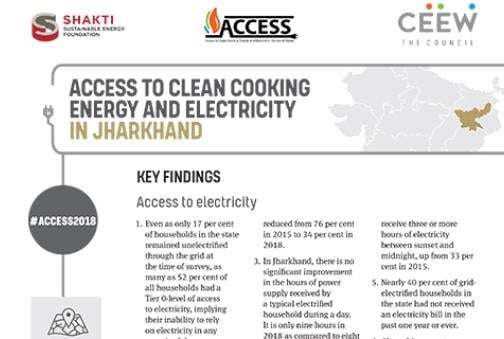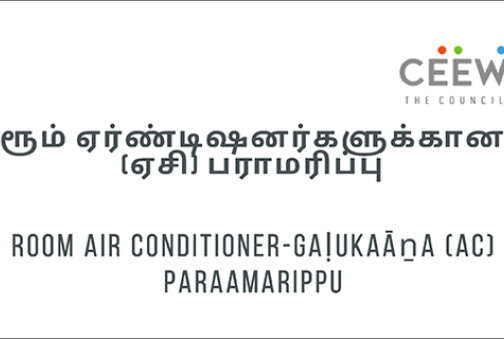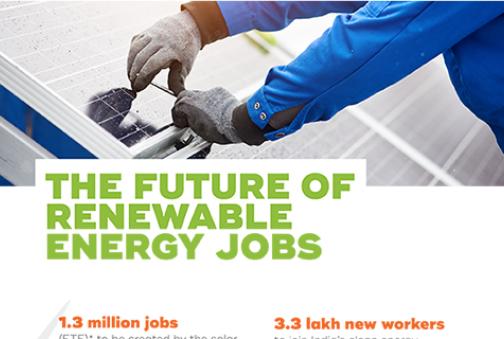




To inform pathways for India to achieve its NDC commitment, the Council on Energy, Environment and Water (CEEW) generated 200+ scenarios for an uncertainty-based assessment. The analysis projects the evolution of India’s electricity generation-mix and energy mix in an uncertain future and analyses the impact of variable renewable energy (VRE) integration cost, energy efficiency improvement rate, and behaviour of energy demand in end-use sectors on these pathways.
It highlights the key uncertainties that India has to address to meet its NDC target of 40 per cent non-fossil share in electricity generation capacity mix, and of reducing the emission intensity (EI) of its GDP by 33-35 per cent from 2005 levels by 2030.

Aligning India’s Climate Policy with National Priorities and Sustainable Development
The Council on Energy, Environment and Water (CEEW) has developed a ‘Synergies and Trade-off Matrix’ to explore synergies between emission mitigation, sustainable development, and national priorities such as land requirement, water use, and employment creation.

After two decades of climate negotiations, developing countries still lack the required capacity to undertake climate reporting. The Paris Agreement underscored capacity building as essential for enhanced transparency within and between countries. This in turn could lend more credibility and legitimacy to every country’s mitigation and adaptation efforts, and increase trust among developed and developing countries.

Access to Clean Cooking Energy and Electricity – Survey of States
The Access to Clean Cooking Energy and Electricity – Survey of States (ACCESS) is India’s largest multidimensional energy access survey conducted by CEEW, Initiative for Sustainable Energy Policy, and the National University of Singapore across six of the major energy access-deprived states – Bihar, Jharkhand, Madhya Pradesh, Odisha, Uttar Pradesh, and West Bengal.

The Access to Clean Cooking Energy and Electricity – Survey of States (ACCESS) is India’s largest multidimensional energy access survey conducted across six of the major energy-access-deprived states – Bihar, Jharkhand, Madhya Pradesh, Odisha, Uttar Pradesh, and West Bengal. The study conducted by the Council on Energy, Environment and Water (CEEW), with support from the Shakti Sustainable Energy Foundation and the Lee Kuan Yew School of Public Policy (National University of Singapore), covered more than 9,000 households from 756 villages in 54 districts collecting about 5 million data points. The results from the first round of the study, ACCESS 2015, highlighted the need to look beyond connections to enable rural India’s access to modern forms of energy. In 2018, we revisited the households to understand the changes in their energy access situation over the last three years, and to study the impact of government policies during this period. The study analyses energy access for households using a multidimensional, multi-tier framework. Households are assigned tiers on the basis of their level of access to energy. Tier 0 indicates the lowest level of access and Tier 3, the highest.

Access to Clean Cooking Energy and Electricity in West Bengal
The Access to Clean Cooking Energy and Electricity – Survey of States (ACCESS) is India’s largest multidimensional energy access survey conducted across six of the major energy-access-deprived states – Bihar, Jharkhand, Madhya Pradesh, Odisha, Uttar Pradesh, and West Bengal. The study conducted by the Council on Energy, Environment and Water (CEEW), with support from the Shakti Sustainable Energy Foundation and the Lee Kuan Yew School of Public Policy (National University of Singapore), covered more than 9,000 households from 756 villages in 54 districts collecting about 5 million data points. The results from the first round of the study, ACCESS 2015, highlighted the need to look beyond connections to enable rural India’s access to modern forms of energy. In 2018, we revisited the households to understand the changes in their energy access situation over the last three years, and to study the impact of government policies during this period. The study analyses energy access for households using a multidimensional, multi-tier framework. Households are assigned tiers on the basis of their level of access to energy. Tier 0 indicates the lowest level of access and Tier 3, the highest.

Access to Clean Cooking Energy and Electricity in Uttar Pradesh
The Access to Clean Cooking Energy and Electricity – Survey of States (ACCESS) is India’s largest multidimensional energy access survey conducted across six of the major energy-access-deprived states – Bihar, Jharkhand, Madhya Pradesh, Odisha, Uttar Pradesh, and West Bengal. The study conducted by the Council on Energy, Environment and Water (CEEW), with support from the Shakti Sustainable Energy Foundation and the Lee Kuan Yew School of Public Policy (National University of Singapore), covered more than 9,000 households from 756 villages in 54 districts collecting about 5 million data points. The results from the first round of the study, ACCESS 2015, highlighted the need to look beyond connections to enable rural India’s access to modern forms of energy. In 2018, we revisited the households to understand the changes in their energy access situation over the last three years, and to study the impact of government policies during this period. The study analyses energy access for households using a multidimensional, multi-tier framework. Households are assigned tiers on the basis of their level of access to energy. Tier 0 indicates the lowest level of access and Tier 3, the highest.

Access to Clean Cooking Energy and Electricity in Madhya Pradesh
The Access to Clean Cooking Energy and Electricity – Survey of States (ACCESS) is India’s largest multidimensional energy access survey conducted across six of the major energy-access-deprived states – Bihar, Jharkhand, Madhya Pradesh, Odisha, Uttar Pradesh, and West Bengal. The study conducted by the Council on Energy, Environment and Water (CEEW), with support from the Shakti Sustainable Energy Foundation and the Lee Kuan Yew School of Public Policy (National University of Singapore), covered more than 9,000 households from 756 villages in 54 districts collecting about 5 million data points. The results from the first round of the study, ACCESS 2015, highlighted the need to look beyond connections to enable rural India’s access to modern forms of energy. In 2018, we revisited the households to understand the changes in their energy access situation over the last three years, and to study the impact of government policies during this period. The study analyses energy access for households using a multidimensional, multi-tier framework. Households are assigned tiers on the basis of their level of access to energy. Tier 0 indicates the lowest level of access and Tier 3, the highest.

The Access to Clean Cooking Energy and Electricity – Survey of States (ACCESS) is India’s largest multidimensional energy access survey conducted across six of the major energy-access-deprived states – Bihar, Jharkhand, Madhya Pradesh, Odisha, Uttar Pradesh, and West Bengal. The study conducted by the Council on Energy, Environment and Water (CEEW), with support from the Shakti Sustainable Energy Foundation and the Lee Kuan Yew School of Public Policy (National University of Singapore), covered more than 9,000 households from 756 villages in 54 districts collecting about 5 million data points. The results from the first round of the study, ACCESS 2015, highlighted the need to look beyond connections to enable rural India’s access to modern forms of energy. In 2018, we revisited the households to understand the changes in their energy access situation over the last three years, and to study the impact of government policies during this period. The study analyses energy access for households using a multidimensional, multi-tier framework. Households are assigned tiers on the basis of their level of access to energy. Tier 0 indicates the lowest level of access and Tier 3, the highest.

The Access to Clean Cooking Energy and Electricity – Survey of States (ACCESS) is India’s largest multidimensional energy access survey conducted across six of the major energy-access-deprived states – Bihar, Jharkhand, Madhya Pradesh, Odisha, Uttar Pradesh, and West Bengal. The study conducted by the Council on Energy, Environment and Water (CEEW), with support from the Shakti Sustainable Energy Foundation and the Lee Kuan Yew School of Public Policy (National University of Singapore), covered more than 9,000 households from 756 villages in 54 districts collecting about 5 million data points. The results from the first round of the study, ACCESS 2015, highlighted the need to look beyond connections to enable rural India’s access to modern forms of energy. In 2018, we revisited the households to understand the changes in their energy access situation over the last three years, and to study the impact of government policies during this period. The study analyses energy access for households using a multidimensional, multi-tier framework. Households are assigned tiers on the basis of their level of access to energy. Tier 0 indicates the lowest level of access and Tier 3, the highest.

Scaling Rooftop Solar: Powering the RE Transition with Households and DISCOMs’
This factsheet provides a snapshot of three utility-led business models to overcome prevailing market challenges in the adoption of residential rooftop solar and create a conducive environment for households, distribution companies (discoms), and developers. Based on The Council's work on rooftop solar with the Delhi discom, BSES Yamuna.







